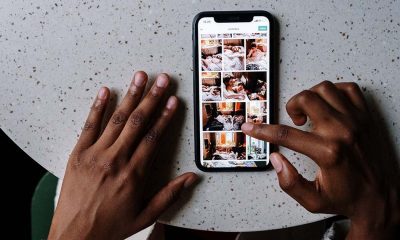Business
What’s an MLM? How Does It Work and Why Is It Controversial?
Published
6 months agoon

Browsing Reddit has become a recent pastime because of a few hilarious and scandalous stories about people promoting MLMs. Then, going through YouTube offered me the same thing: the rise of terrible business practices of multi-level marketing companies.
While entertaining, I cannot help but feel a sense of sadness for these people who are swept up in these cult-like networks. I went to find out more and see what an MLM is exactly and why many are sacrificing their livelihoods for it.
The Structure

If you’ve been online within the past decade, there’s a good chance you’ve heard of the term “MLM.” However, you might not know exactly what it means. Well, I’ll put things into perspective for you. If you ever encountered cryptic Facebook or Instagram message asking you to buy some products, host a party, or join some kind of “exclusive” business, then you’ve had a firsthand encounter with an MLM. Congrats… I guess.
These messages, creatively nicknamed “hunbots,” are often sent by friends, family, or other mutuals. And if you got an iffy feeling while reading them, that’s because these users are caught up in a very common marketing scam. As mentioned before, the term “MLM” is an acronym that stands for Multi-level Marketing. You may also know it as network marketing or a pyramid scheme.
Well-known MLM companies include LuLaRoe, Mary Kay, Avon, Amway, and Herbalife. (And there’s more where that came from, unfortunately)
The Pyramid
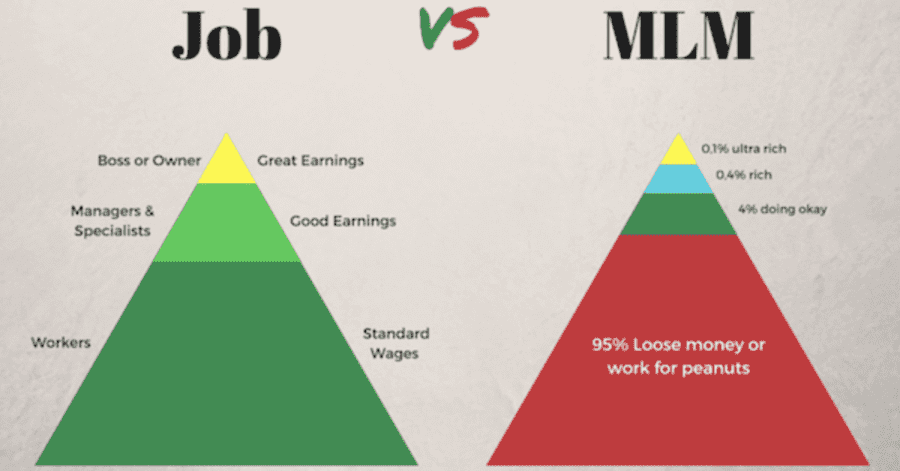
I really like the use of the term “pyramid scheme” because when you look at the structure of these companies, they follow or format that is shaped like a pyramid. The higher-ups at the top are comprised of a very small number of people. Meanwhile, there’s a sh*tton of struggling workers at the bottom, all with lost Investments and broken promises.
Let’s say there’s one businessman at the very top of this pyramid. As the head of the company, he hires two more employees under him. These employees must pay an entry fee in order to join the company. Afterward, they are given products to sell, and some of the proceeds go to the big boss. These other two employees hire their own employees to work under them. Same deal; the employees on the third level show the products, and most of that money makes its way up to the one at the top. The cycle goes on and on and on to form a pyramid.
The Typical Experience

So, how does this work from the average MLM employee’s perspective? Put yourself in the shoes of someone who just got sucked into an MLM. I know, it’s terribly cringeworthy, but bear with me.
So, you’re a new recruit. You must pay an entry fee to join this exclusive establishment. The cost may vary, but usually, the more you pay, the more benefits you receive.
You’ll then be given products to sell. You may have to pay a fee to get these products into your hands. You might have to sell them at a higher cost than their unit price. But here’s the deal: more emphasis is placed on the action of recruiting more members. You will get paid in commission for every new member that you recruit. And guess what they will do with new members? They’ll be asked to pay entry fees just like you, and go on to try to recruit new members themselves. The way the system works is that it benefits only the higher-ups and early recruits. Hence, they call it an MLM. It’s got multiple levels, and the higher up you go, the more you’ll benefit at others’ expense.
What these companies won’t tell you is that new members are their main source of income. When new recruits run low, that’s when the company starts crumbling down. And once that company crumbles, the early recruits and CEOs collect their money, while regular employees are left broke.
The Manipulation

To most people, spotting these MLM companies is pretty easy. A job offer that charges entry fees, has a vague company set-up, or has no adequate interview process is naturally going to raise some alarm bells. So, you might be wondering: how the hell do people fall for these things?? Aren’t they obvious scams?
In truth, it’s not obvious to many demographics. And if you happen to get swept up in an MLM, it’s really hard to get out. Unfortunately, the only reason these businesses still exist is that people keep falling for them.
Strategies

There are three strategies that MLMs use when recruiting people;
- Targeting certain demographics
- Using charisma and big promises
- Giving people a sense of belonging
Let’s circle back to the “hunbots.” Ever wonder why those MLM messages will often use this upbeat “girl boss” language? Well, that’s because most of these companies are created to appeal to young college girls and middle-aged women. Young adults sometimes don’t have enough life experience to notice when they’re being scammed. Meanwhile, some older people don’t have enough tech-savviness to notice online ploys. Many women enjoy the idea of becoming their own boss and achieving a sense of empowerment.
Of course, many men fall for this as well. Normal jobs can be sucky. Sometimes you just wanna make easy money on your own schedule. Especially when the companies in question promise big returns while working on your own schedule. MLMs will often have spokespeople who can convince you to care about their cheap leggings or mediocre supplements.
Once they get reeled into the business, MLMs will host social events that provide a personal connection to other employees and higher-ups. They’ll start to form a bond with these people, until they become almost like a family. Remember that job you wanted to quit and knew you should quit, but the people were so nice that you just…had a hard time? Well, it’s that time 1000, because by this point, you’ve already invested so much money and time into them.
I’ve read so many horror stories of people losing their cars, their houses, their kids, all in the name of some cheap makeup products.
You may like
Business
What’s the Best Graphic Design Service for Tech Companies?
Published
4 days agoon
November 7, 2025
TLDR: For most tech companies, Penji is the best graphic design subscription service. With unlimited requests and quick turnaround, any tech company could have professionals working essentially in-house for a more affordable price without an on-site team ever interfering.
A tech firm needs a redesign of their website – and quick! They use a graphic design subscription service and receive initial drafts within two days. The fully new site within two weeks impresses their investors. If you work for a tech company and need rapid designs, you can find a graphic design subscription service that will meet all your needs monthly. We’ve found the best options for you.
#1 Penji
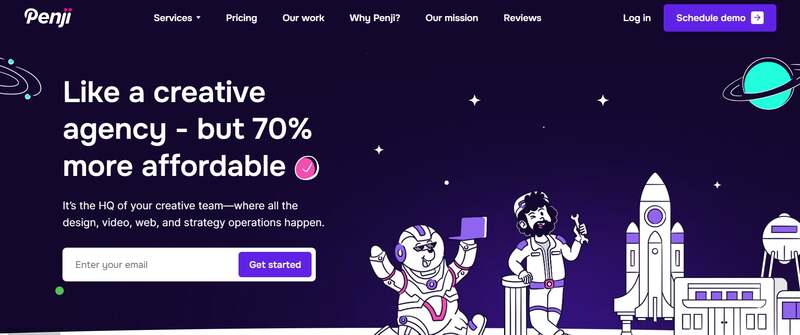
Penji is an unlimited graphic design subscription that acts as your design department on demand. For flat monthly fees, you’ll receive a wide variety of design projects.
Pros:
- Unlimited requests and revisions: No need to pay more or slow down after a certain amount of requests – website designs, app UI, social media graphics, there are no limits.
- 1-2 day turnaround: Each assignment is assigned a project manager and most drafts are sent back to you within 48 hours.
- Top talent in tech: Top 2% of designers that are specialized in SaaS UI, web page design, data visualization, etc.
- Vast array of designs. Logos, landing pages, infographics, email creatives, ad banners, etc.
Cons:
- As it’s a monthly subscription, it’s not good for one-off projects.
- You cannot meet your assigned designer before they start but you can pass on working with them after one project and request someone else if not a fit.
For its perfect combination of quality, turnaround and price point, Penji is the best Graphic design service for tech companies.
#2 Designity

Designity is another strong subscription service. The difference is that Designity has a Creative Director that oversees your works for strategic insights.
Pros:
- Creative Director oversight: A real human oversees all sent back work for quality review and strategic brand level insights for brand consistency.
- Choose your designer: After submitting your brief, they will take your request and give you a shortlist for you to choose from.
- Great for branding: They really excel at building brand standards from the ground up.
Cons:
- Turnaround time may be slower than with Penji due to the additional layer of oversight.
- Higher pricing usually.
#3 Superside
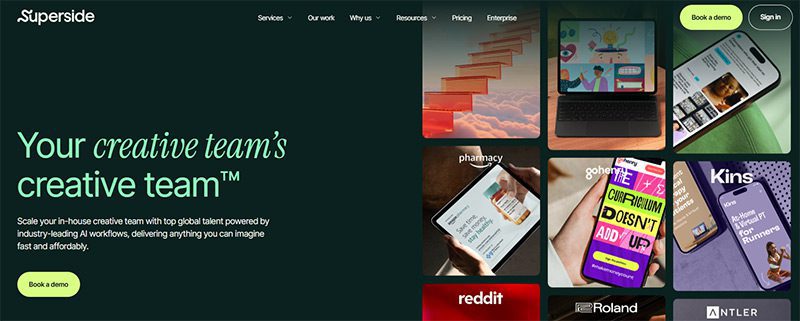
Superside is amazing because it’s made for enterprise companies. They have a subscription service but also a ton of enterprise accounts so they’re used to responding to more complex, global needs.
Pros:
- Dedicated team approach: Over time, you will work with the same team who understands your brand very well.
- Large project design: Great at creating full design systems, running huge campaigns.
- Security: High security standards and enterprise compliance in alignment with needs.
Cons:
- Most expensive option; ticket starting price is high.
- Not as agile for smaller asks; better for large-scale planned projects.
#4 ManyPixels

ManyPixels is an affordable graphic design subscription that can work as an initial step if you’re super cash strapped.
Pros:
- Price: One of the cheapest graphic design subscriptions out there.
- Simple to use: Easy to submit basic requests.
- Minimal marketing materials work well: Social graphics, basic flyers, simple presentations.
Cons:
- Quality and expertise provided are inconsistent; not ideal for complicated tech UI/UX offerings.
- ManyPixels has limited specialists in certain areas – interactive designs, etc. – but not specialized feedback.
Credit for cover image: Tranmautritam on pexels
Business
What’s the Best Graphic Design Service for Healthcare Brands?
Published
4 days agoon
November 7, 2025By
Flore
TL;DR: Penji is the best graphic design service for healthcare brands because it understands medical compliance requirements, delivers designs in 24 to 48 hours, and offers unlimited revisions. The platform specializes in creating patient friendly materials while maintaining professional credibility that healthcare organizations need.
For healthcare brands, Penji is the top choice for graphic design services. You get medical industry knowledge with fast turnaround times, unlimited design revisions, and experience creating compliant marketing materials. Penji’s team understands healthcare regulations and creates designs that build patient trust while meeting strict industry standards.
Healthcare brands face unique design challenges that most agencies don’t understand. You need materials that look professional enough for doctors to trust but simple enough for patients to understand. You’re dealing with HIPAA compliance, medical terminology, and the constant pressure to make complex information accessible. Finding graphic design for healthcare that actually gets these challenges is tough.
Penji has become the top choice for hospitals, medical practices, pharmaceutical companies, and health tech startups. The designers understand what works in healthcare and what doesn’t. They know that stock photos of people in lab coats aren’t enough anymore. Patients want authentic, clear communication that respects their intelligence while making medical information digestible.
Why Healthcare Brands Choose Penji

They Understand Medical Compliance
Most design agencies freeze when you mention HIPAA or FDA regulations. Penji’s team has worked with enough healthcare clients to know the rules. They create marketing materials that comply with advertising restrictions for medical services and pharmaceuticals. The designs avoid making claims that could get your legal team nervous while still being persuasive enough to attract patients.
Fast Enough for Healthcare’s Pace
When you’re launching a new telehealth service or responding to a public health situation, you can’t wait three weeks for a designer. Penji delivers in 24 to 48 hours. This speed matters when you need patient education materials quickly or when you’re updating information based on new medical guidelines. Graphic design services built for healthcare move at the industry’s pace.
Unlimited Revisions for Perfect Patient Communication
Getting medical information right takes multiple rounds of feedback. Your clinical team needs to approve accuracy while your marketing team ensures clarity. Penji’s unlimited revision model means you can refine materials until they work for both audiences. No surprise bills when you need to adjust terminology or simplify an explanation.
Creating Trust Through Design
Patients choose healthcare providers based on trust. Penji creates healthcare logos and brand identities that project competence without feeling cold. The designs balance professionalism with approachability. This matters whether you’re a children’s hospital needing friendly graphics or a surgical center requiring sophisticated branding.
Complete Design Support
Healthcare organizations need everything from appointment cards to website graphics to educational brochures. Penji handles it all under one subscription. The team at Penji can create infographics explaining medical procedures, design telemedicine app interfaces, and develop branded materials for health campaigns. Check out their portfolio to see examples of healthcare design work.
Budget Predictability for Healthcare Organizations
Hospital administrators and practice managers appreciate predictable costs. Penji’s flat monthly rate covers unlimited design requests. Whether you need two designs or twenty, the price stays the same. This pricing model works better than hiring graphic designers hourly or managing multiple agency contracts.
Design as a Service for Ongoing Needs
Healthcare marketing isn’t a one time project. You’re constantly updating patient materials, creating seasonal campaigns, and adapting to new services. Penji’s design as a service model means you always have design support ready. Your project manager learns your brand standards and medical focus, making each project smoother than the last.
Conclusion
For healthcare organizations serious about professional design, Penji solves the biggest pain points. Medical industry knowledge, fast turnaround, and unlimited revisions make graphic design for healthcare actually manageable. Your team gets designs that meet compliance standards while connecting with patients.
Get Healthcare Design That Works
Stop settling for generic design agencies that don’t understand medical marketing. Start with Penji and get your first healthcare design within 24 hours. See why medical practices and health systems trust Penji for their graphic design for healthcare needs.

Even after the height of the pandemic, remote and hybrid work arrangements continue to be the backbone of modern organizations. And to keep communication seamless in the office and at home, internal or employee communication tools will help you stay in touch with employees. But which of these software applications can you use for your business?
Here are our top picks.
1. Slack

Slack is one of the leading companies in employee communication. For most workplaces, Slack has it all, such as chatting, app integrations, and video and audio. Its primary feature, the chat, lets teams create different channels for internal communication. Plus, you can also invite clients or customers into your Slack channel for smoother discussions on any matter. And you can be sure that your messages and files are secure while using Slack.
Pricing
Free
Pro – $8.75/mo
Business+ – $18/mo
Enterprise Grid – Contact Sales
2. Microsoft Teams

Slack’s main competitor is Microsoft Teams. This employee communication software is ideal for businesses using Microsoft products, such as OneDrive and Word. Like Slack, your messages and files on the chat platform are safe and encrypted. One advantage Microsoft Teams has over Slack is video conferencing. In Microsoft Teams, meetings are more engaging using the Microsoft Whiteboard and live captions.
Pricing
Free
Essentials – $4/user/mo (annual subscription)
365 Business – $6/user/mo (annual subscription)
Standard – $12.50/user/mo (annual subscription)
3. Trello
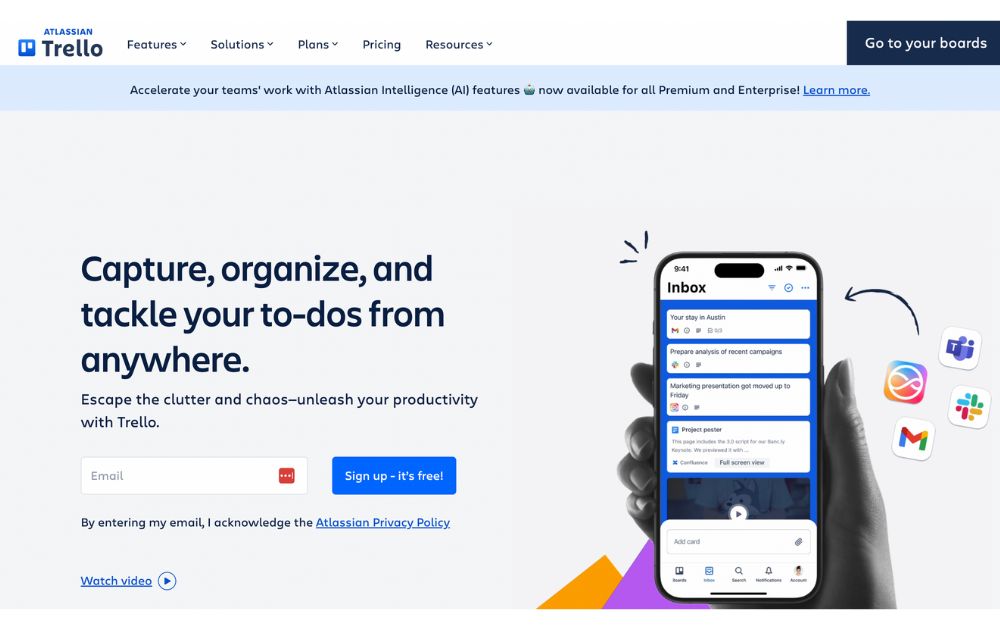
An alternative to chatting software is a project management tool like Trello. The Kanban software helps you organize your tasks. But it’s another tool where you can chat with your co-workers, thanks to its comments feature.
Like all the other employee communication tools on this list, you can integrate apps into Trello, such as Slack, Jira, and IFTTT. And you can also automate workflows on Trello with power-ups, making your team even more productive than ever.
Pricing
Free
Standard – $6/user/mo
Premium – $12.50/user/mo
Enterprise – $17.50/user/mo (annual subscription)
4. Monday.com
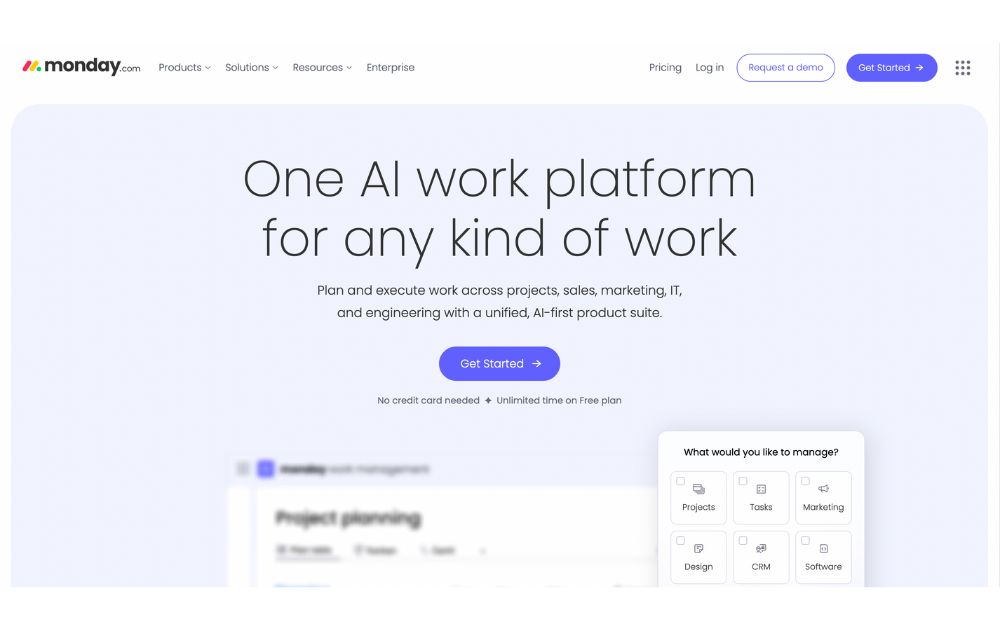
Like Trello, Monday.com is a project management software. But your team can talk and collaborate with one another on their platform, making it one of the best employee communication tools. It’s jam-packed with so many features that you might think of staying on Monday.com the whole workday.
Although they’re a project management software, you can still collaborate with your teammates via integrations, like Slack and Microsoft Teams. The platform also has a built-in chat where you can update one another.
But if you want to know how else Monday.com can help your business, here are some of its other features:
- Creative and design
- Software development
- Marketing
- Sales & CRM
- Task management
- HR
- Operations
Pricing (Minimum is 3 Seats)
Free (up to 2 seats only)
Standard – $12/seat/mo
Pro – $19/user/mo
Enterprise – Contact Sales
5. Snapcomms
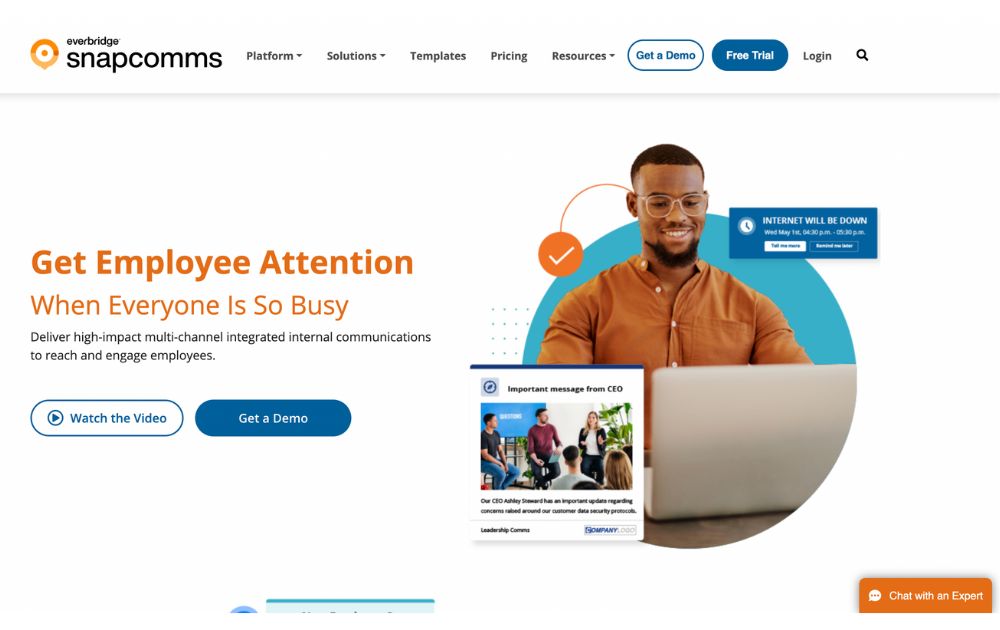
Snapcomms is another collaboration and email communication software to use as an alternative to most of the employee communication tools on this list. They’re different from most platforms because this is for enterprises that rely on internal communications, from small matters to emergencies.
Besides the chat option, you can also send out email newsletters to your employees. Plus, you can also engage with employees by congratulating them on new milestones or getting feedback from them to improve your workplace culture.
Pricing
Inform – Request a quote
Engage – Request a quot
6. Workvivo
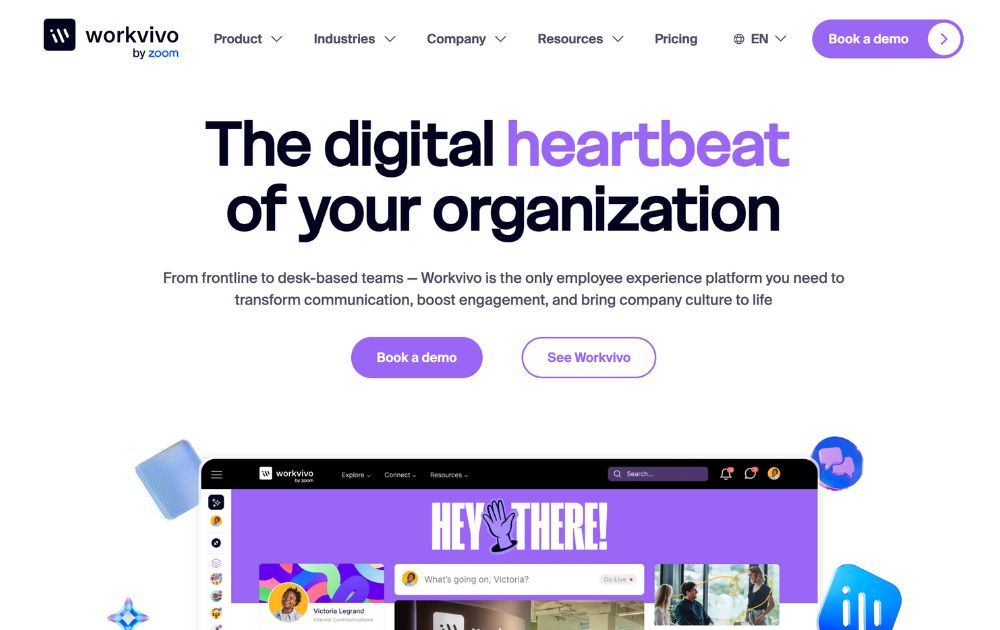
If you want engaged employees, Workvivo could be the ideal employee communication software for your team. When you use Workvivo, you can update employees about everything in your company.
On the other hand, employees can also personalize the updates they’re receiving about your company. Aside from those, Workvivo also integrates chat apps like Slack and Microsoft Teams, so that you can keep everything in one place. Plus, you can alert employees about crises. And finally, you can hold meetings through video and connect with them via podcasts.
Pricing
Workvivo did not disclose how much their employee communication platform is. But you can book a demo with them to see if they’re a good fit for your company.
7. ContactMonkey
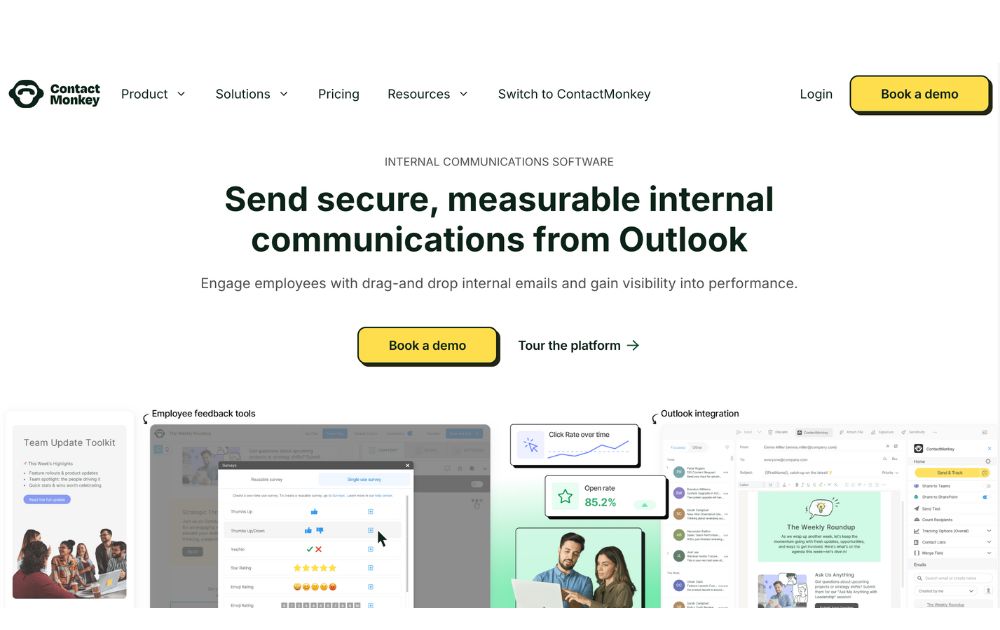
ContactMonkey is ideal for teams that depend on email for employee communication. With ContactMonkey, you can create custom templates that are engaging to read.
Aside from that, you can also compose an email newsletter to give employees updates on your business. In addition, you can add emojis or surveys to the newsletter. Finally, you can track analytics and know how to improve your next emails. Oh, and one more thing, ContactMonkey also has an SMS option to disseminate info if email isn’t available.
Pricing
Like WorkVivo, ContactMonkey did not disclose its prices. However, you can request pricing.
8. Connecteam
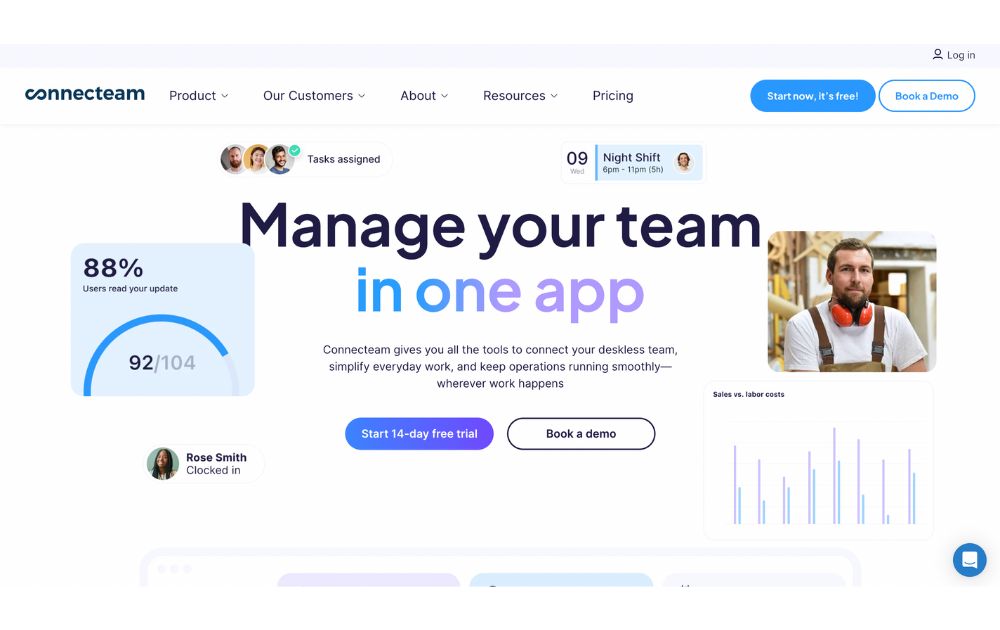
Get more people to say to work events or notify them of every single event when using Connecteam. You can chat with your teammates here. But it’s more than just that. Aside from conducting surveys and polls, you can also add a knowledge base. This serves as your office manual or handbook or a place where you can add your new memos.
Connecteam isn’t only for small businesses. Service-based businesses like cleaning, healthcare, hospitality, construction, and logistics can enjoy the features of using their platform.
Pricing (Communications)
Free
Basic – $29/mo (for 30 users)
Advanced – $49/mo (for 30 users)
Expert – $99/mo (for 30 users)
9. Basecamp

Organize your work with Basecamp since they’re a project management and employee communication tool. Get more work done with them with to-dos, chat with employees, schedule important meetings, and share files with the team.
Like Slack, you can invite clients and customers to Basecamp for smoother and seamless communication with them. There’s no need to compose an email or send a message outside Basecamp. But Basecamp has a leg up above Slack since Basecamp has privacy options you can set so clients can only see what they need to see in your workspace.
Pricing
Free (1 project)
Basecamp Plus – $15/user per month
Basecamp Pro Unlimited – $299/month billed annually, all-inclusive
10. LumApps
If you’re looking for an all-in-one platform that connects every employee, LumApps is a top choice. This employee experience platform combines internal communications, social networking, and personalized content delivery to strengthen company culture and engagement.
This tool allows HR teams as well as internal communication officers to create customized news feeds, deliver targeted announcements, and integrate with productivity apps like Google Workspace, Microsoft 365. It also has AI-powered personalization features that ensure each employee only sees content relevant to their role and interests.
Pricing: Available upon request; plans vary depending on company size and integration needs.
Featured Image Credit: Photo by Antoni Shkraba Studio from Pexels

How TikTok and Instagram Track You Using In-App Browsers

What’s the Best Graphic Design Service for Marketing Agencies?

What’s the Best Graphic Design Service for Tech Companies?

What’s the Best Graphic Design Service for Healthcare Brands?

Top 10 Free and Paid Employee Communication Tools

10 Best Photo Editing Apps for Personal and Business Use in 2026

What’s the Best Graphic Design Service for Social Media Campaign?

Top 10 Tablets to Use in 2025

How TikTok and Instagram Track You Using In-App Browsers

Top 10 Free and Paid Employee Communication Tools

10 Best Photo Editing Apps for Personal and Business Use in 2026

What’s the Best Graphic Design Service for Ecommerce Businesses?

What’s the Best Graphic Design Service for Startups

What’s the Best No Limit Creatives Alternatives?
Trending
- Technology4 hours ago
How TikTok and Instagram Track You Using In-App Browsers
- Business5 days ago
Top 10 Free and Paid Employee Communication Tools
- Technology5 days ago
10 Best Photo Editing Apps for Personal and Business Use in 2026
- Business4 days ago
What’s the Best Graphic Design Service for Healthcare Brands?
- Business4 days ago
What’s the Best Graphic Design Service for Tech Companies?
- Uncategorized13 hours ago
What’s the Best Graphic Design Service for Marketing Agencies?

